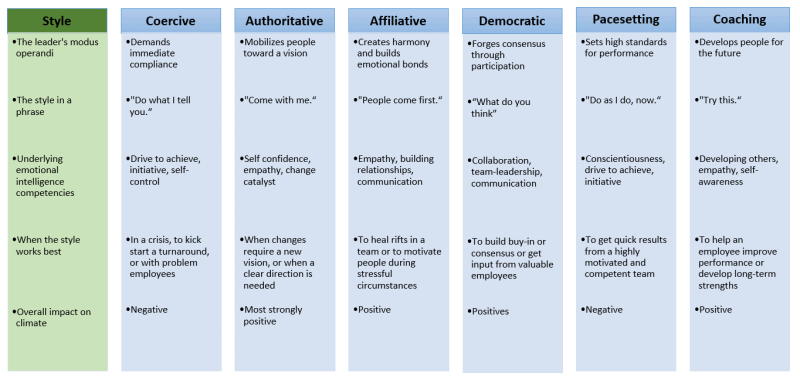What are the Six Emotional Leadership Styles?
While there are many different types of leadership, emotional leadership styles are thought to be some of the most effective.
Emotional leaders can connect with their team members and create a positive work environment. They can motivate their team members and inspire them to achieve great things.
In leadership, “emotional” is usually associated with emotions that lead us to feel a certain way. While we all deal with emotions, which can be very intense, that does not mean that all leaders will deal with emotions the same way. Some leaders may do a better job handling their emotions than others.
In their book “Primal Leadership,” published in 2002, Daniel Goleman, Richard Boyatzis, and Annie McKee defined six emotional leadership types. Each style affects people’s emotions differently and has advantages and disadvantages in particular situations.
Visionary, Coaching, Affiliative, and Democratic are four types that encourage harmony and excellent outcomes. On the other hand, the other two (Commanding and Pacesetting) may cause stress and should only be used in certain situations.
What are Goleman’s Six Leadership Styles?
Goleman’s Six Leadership Styles are a set of distinct approaches leaders can use to lead their teams effectively. These styles were developed by Daniel Goleman, a renowned psychologist and author of the book “Emotional Intelligence.” According to Goleman, each style has unique characteristics and is best suited for specific situations. Understanding these styles can help leaders determine which approach will work best in different circumstances.
The first leadership style is called “coercive.” This style involves giving orders and expecting immediate compliance from team members. It works well when quick action is required or when dealing with problematic employees who need discipline. The second style is “authoritative,” which utilizes vision and inspiration to motivate team members towards a common goal. This approach works well when implementing changes or leading during times of uncertainty.
1) The Authoritative (Visionary) Leader
This style is “based on a hierarchical approach to leadership, often characterised by a strict hierarchy and high levels of control.” The leaders of such organisations “rely on the use of punishment and threats to discipline their subordinates.”
Authoritative leadership involves giving and accepting power. It is a type of leadership that does not allow a person to dominate others. This style is usually used when a person does not feel they are a suitable leader for a particular situation.
An example of an authoritative style may be you showing your anger by ordering your employees around. An example of a father or head teacher may be to show his authority by ordering his children about.
2) The Coaching Leader
Coaching leadership style is used when you want to get a commitment from other people for what you want to do. It’s all about helping people to understand what is needed and to support them to get this done.
Coaching is a leadership approach that links a team member’s personal aspirations and ideals to the organisation’s objectives. Since it is compassionate and encouraging, you may utilise this approach when focusing on developing individuals for future success.
This approach focuses on in-depth discussions that may have nothing to do with people’s current jobs instead of concentrating on long-term goals and their relation to the organisation’s mission.
3) The Affiliative Leader
The affiliative leadership style stresses emotional relationships and encourages team cohesion. It brings people together by promoting inclusiveness and resolving disagreements. To apply this technique, you must regard others’ feelings and be acutely aware of their emotional needs.
The Affiliative leadership style is built on trust, honesty, and respect for people. This personality type believes in treating others with kindness and compassion rather than criticism or judgment. Affiliative leaders are typically good communicators and build relationships based on mutual respect and trust. Affiliative leaders are known for being fair and good listeners, so they build consensus with their team rather than imposing their own will on others.
Affiliative leaders can help lead by listening and understanding how to be good listeners. An Affiliative leader can listen to their team members without judgment and help them understand how to communicate with the Affiliative leader. The Affiliative leader can then lead by modelling effective listening and asking questions in order to learn more about what they can do to move the group forward.
4) The Democratic Leader
Democratic leadership is based on equality, fairness, and inclusiveness concerning the whole community, and it’s more about individual development. The democratic leadership style is characterized by the concept of collective leadership.
A leader is expected to know their followers’ feelings, ideas, hopes, desires and demands while at the same time be sensitive to their problems and helping them to realize what they want. It’s also necessary that the leader knows what his followers think of him.
Democratic leadership is based on individual and collective autonomy, and democracy is based on freedom, equity and fairness. When a leader behaves dictatorially, the people obey him with fear, while when a leader behaves democratically, the people obey him with respect and love.
5) The Pace-setting Leader
The pacesetting leadership style places emphasis on performance as well as the successful completion of goals. Leaders that use this style of leadership have high expectations for the performance of their employees, and they frequently take action themselves to ensure that goals are accomplished.
Everyone is held to a high level in the Pacesetting approach, so there is no room for bad performers to get special treatment. While it may be beneficial, this approach can have a detrimental impact on the group as a whole, leading to feelings of burnout and tiredness as well as increased worker turnover.
6) The Coercive (Commanding) Leader
Commanding leaders use autocratic leadership. Orders, the (often implicit) fear of disciplinary punishment, and tight control are all important factors. It’s crucial to keep in mind that individuals in democratic nations are accustomed to having a high amount of control over their lives and work and that this method may strip them of that power.
An autocratic leader possesses absolute rule over the organization and its subordinates; the subordinates are entirely under the control of the autocratic leader. In a democratic form of leadership, the decision-making process is controlled by consensus. The autocratic leadership style is the extreme opposite of autocracy. The autocratic leader may be considered a person capable of achieving absolute rule and absolute power. He also considers himself a god and can interfere in almost every area of the organization.
Why use Goleman’s Leadership Style?
Consider the finest boss you’ve ever had for a second. What about working with him or her made it so enjoyable?
Maybe your boss was happy and enthusiastic about his work, which also made you happy and enthusiastic. When issues arose, he never became enraged, instead of focusing on finding effective solutions. He was self-assured, yet he was always open to hearing what others had to say. Consequently, you thoroughly liked your work and constantly delivered excellent results.

Consider the worst supervisor you’ve ever had: the irritable one made unreasonable demands without explanation and was constantly “pulling rank.” Sure, you worked hard because you were terrified of not doing so.
In the near term, he generated successes, but his team members quickly burnt out, and employee turnover was rampant.
The difference between the two managers is striking, which might be necessary. According to scientific evidence, a leader’s emotional condition influences everyone in the company. The leader’s mood can set off a chain reaction that has an impact on not just morale but also productivity and profits.
As a result, as a leader, improving your emotional intelligence (EI) – your capacity to control your own emotions as well as interpret others’ – is a crucial business skill.
What are Situational Theories of Leadership?
Situational leadership theories give leaders a set of rules they should use for making decisions at any given time. It gives leaders a list of things they should do instead of choosing their strategy.
Situational theories of leadership are a type of leadership theory that focuses on the specific context or environment in which a leader is operating. These theories focus on how the leader’s personal characteristics, organisational characteristics, and situational factors interact to create an effective leadership style.
Some staff, for example, work better under a more dictatorial and directive supervisor. Others will have a better chance of succeeding if the leader can step back and allow his team to make decisions and carry out plans without direct participation. Similarly, not all sectors and corporate contexts equally need the same abilities and leadership characteristics.



